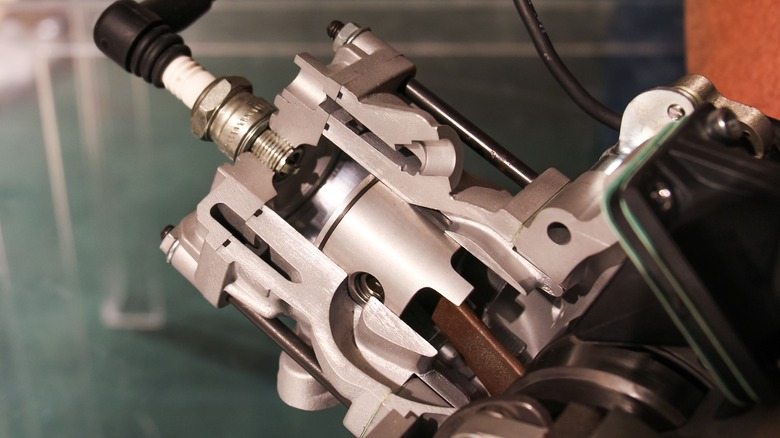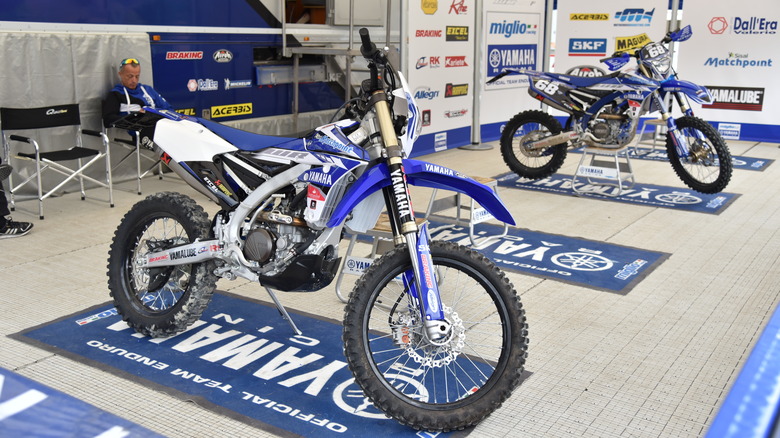
Artur Didyk/Shutterstock
Name a type of terrain, and someone, somewhere, will figure out a way to race on it. From wood-track ovals and countryside rallies to the pure chaos of the Gumball 3000, humans love to pit themselves and their machines against each other in competition.
Motocross is one of the most physically demanding forms of racing. Originating in the United Kingdom, off-road motorcyclists have been busting kidneys as far back as 1924 when automotive clubs began hosting «scrambles» to see who was fastest through the woods. But it wasn’t until the 1960s that the sport evolved, pitting racers against each other on tight tracks with custom-built off-road bikes designed for the task.
Since its introduction to America in 1972, motocross has been a playground for motorcycle enthusiasts. Over the past half-century, dirt bikes have undergone a revolution in technology. From improved suspensions to the use of lightweight, heat-resistant materials and innovations in safety gear, modern motocross has transformed into a high-tech sport that’s almost unrecognizable compared to its early days.
But there is one technological arena upon which not all motocross aficionados agree. It remains a hot topic of contention on amateur forums and professional publications: The disappearance of the two-stroke engine from the American Motorcycle Association (AMA) Motocross Championship ranks. No longer does the buzz of furious hornets sweep through the ruts and over the tabletops of professional motocross. We examine how the two-stroke disappeared from motocross and whether it’ll ever return.
Two-stroke vs. four-stroke

Officina23/Shutterstock
Every internal combustion engine has to complete two missions— set the conditions to create an explosion and evacuate the byproducts of that explosion in the form of exhaust. Each stroke pushes or pulls a piston attached to a crankshaft, sending power through the transmission and, ultimately, to the drive wheel, which moves the vehicle. The fundamental difference between a two-stroke and a four-stroke engine is the number of strokes it takes to complete the explosion and exhaust sequence, but it’s not the only one. Within this process across both models are several technological dissimilarities.
One potential downside of two-stroke engines is they require gasoline mixed with oil. Not good for the environment, the blue smoke produced by this sort of gas has earned these engines the nickname «smokers.» The upside is a superior power-to-weight ratio compared to four-strokes, better starting in cold temperatures, and freakish and twitchy high-rev power. Due to fewer and less complex moving parts, the head of a two-stroke motor is lighter, cheaper to produce, and more accessible for maintenance by amateur mechanics or those with limited tools.
Four-stroke engines have their own set of advantages and disadvantages. They are more technically complex, expensive to produce, and difficult to work on, raising the barrier to entry for many would-be motocross racers. But they have taken over for a reason: Lower emissions, improved fuel efficiency, and more torque across the lower end of the power band have earned them a reputation on the race track.
Two-strokes on the street and in the dirt

GolfStandard/Shutterstock
The history of the two-stroke engine is almost as old as the history of internal combustion, with the first iteration appearing as far back as 1878. But it was in the mid-20th century that the practical application of two-strokes in motorcycles became popular. By the 1960s, the two-stroke engine powered superbikes in the GP World Championship. And like so many technologies developed by race teams, it found its way to the street.
Major manufacturers began building buzzy bikes with streaky speed and two-stroke charm. Yamaha made the RD350, Suzuki the RGV250 and RG 500, and Kawasaki the H1 Mach III and H2 750 Mach IV. Ultimately, government emissions regulation killed the «two-smokers» for street use. By the mid-1980s, most had disappeared in favor of cleaner-burning four-strokes. But they could still be found racing America’s dirt tracks and backwoods trails.
Throughout its infancy and adolescence, motocross made almost exclusive use of two-strokes. The peaky and powerful lightweight engines were perfect powerplants for climbing hills, leaning into sharp turns, and sending motorcycles through the air. Two-strokes in the dirt long outlasted their street brethren, but in the end, the four-stroke caught up, and within a few years of transition, they had disappeared entirely from the sport.
What killed the two stroke in motocross?

Leonardodesign21/Getty Images
The beginning of the end for the relationship between two-strokes and AMA Pro Motocross and Supercross came in the form of the Yamaha YZ400F. Introduced for the 1997 Supercross series, the four-stroke Yammie was a one-off build Yamaha executives had talked AMA into accepting on the premise of environmental safety. AMA agreed that if the company mass-produced the motorcycle, it could indeed enter its bike into the pro circuit.
The YZ400F debuted on May 17, 1997, at the final race of the season in Las Vegas. Those who had heard about the bike doubted its efficacy, as two-strokes were simply the answer in motocross at the time. But Rider Doug Henry opened a two-second gap in the first lap and struck the first nail into the coffin of the two-stroke in motocross. The heavier engine stabilized the bike, delivered superior torque, and exposed the weaknesses of the zippy two-strokes. Motocross never looked back.
AMA ultimately allowed two-strokes and four-strokes to compete against each other, with one major caveat: Two-strokes needed to have half of the displacement. In other words, two-stroke 125cc bikes would have to race 250cc four-strokes, and 250cc two-strokes against 500 cc four-strokes. The die was cast. After a few years of mixed-class racing, it was no more — the day of the two-stroke was over. If you tune into an AMA Motocross series today, you’ll see nothing but 250cc four-strokes and 450cc four-strokes. The day of the two-stroke was over.
The future of the two stroke in motocross

Peopleimages/Getty Images
The good news is that two strokes are alive and well despite their absence from the pro-circuit. Cheaper and relatively easy to maintain, amateurs and weekend warriors are still zipping their way around dirt tracks all across the country. Two-strokes command a cult following, and their distinctive buzzy exhaust note is looked upon fondly by old-timers who remember the days of yore and young riders who maintain their own bikes. Wealthy factory teams also don’t need to worry much about the higher maintenance cost. In fact, there is still a call for the return of the two-stroke.
Major manufacturers have not given up developing two-stroke motorcycles. In the 20 years or so since they faded from motocross, technological advances have made them burn cleaner and produce even more power than ever before. While the future of the two-stroke at the highest level of motocross racing is up for debate, there is little doubt that it will have a place at amateur events and dirt trails throughout the country for a long time.